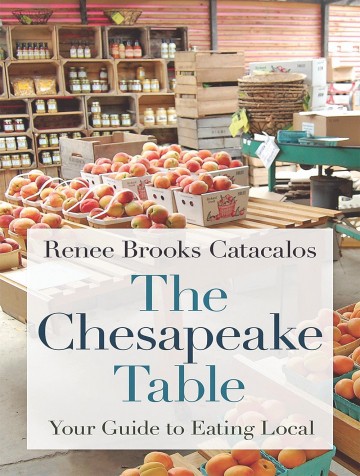Cookbooks to Whet Your Holiday Appetite
The New Chesapeake Kitchen
by John Shields with photographs by David W. Harp; John Hopkins University Press: $26.95
Old cook or new, for yourself or a gift, you can’t do better than John Shields’ newest, published last year in culmination of many years’ research. Shields ranks as our signature Bay chef. As author of the earlier Chesapeake Bay Cooking, host of the PBS show Coastal Cooking with John Shields and proprietor of Gertrude’s Restaurant at the Baltimore Museum of Art, Shields has introduced the world to his native cuisine.
“I figured we needed to take a look at where we are right now in the Bay so we can try to imagine our Chesapeake kitchen for the 21st century in a number of aspects,” Shields told me between judging rounds at the National Oyster Cook-off, where he and I (and Gwyn Novak, see below) are judges.
“We’ve made great strides in cleaning up the Bay,” for one, he said. “For another, young people have returned to growing and making local food, from artisan foods, to cheese making to mead works, whiskies, and wine making to oyster farming, also restoring whole areas of the Bay. It gives us hope for the future.”
Twelve chapters including many recipes, all with John’s introduction, ranging from Wide Net Blue Catfish Catties to Fluffy Cornmeal Pecan Biscuit Dough. Many are paired with wish-yours-looked-so-good photos. Plus key local resources and suggested readings.
by Gwyn Novak; Rockridge Press $14.95
Once upon a time, Gwyn Novak was a beginning cook. She’d grown up so well-fed with her grandmother, owner of a landmark restaurant in Solomons Island, and her mother, a home-economics teacher, that she didn’t need to cook. Stress from a policy job drove her to the kitchen, and love of creating there took her to culinary school. She founded No Thyme to Cook first as a home business, then in her grandmother’s former restaurant, where she offers classes to cooks of all ages and interests.
In How to Cook, she’s channeled both stages of her life into a useful book that will enchant willing beginners yet have a thing or two to teach experienced cooks. Its fundamental strength is organization: She starts with equipping your kitchen, moves to best practices, then devotes six chapters to useful basics, inlcuding some tips you might have missed along the way. Each chapter culminates in a Now You Try recipe.
Then come the range of recipes, organized by meal time and snack time, all chosen to be highly appealing to young palates and each matched with an alluring full-color photo.

The Chesapeake Table
by Renee Brooks Catacalos; John Hopkins University Press: $24.85
Catacalos introduces readers to the local food movement in the Chesapeake, with a focus on sustainability, equity and diversity in farming and accessibility for all eaters.
The former publisher of Edible Chesapeake magazine, she has been involved with local food for decades, and her food pedigree is legitimate: her father was a chef at the old Blackie’s House of Beef in Washington, D.C.
Her personal challenge to eat local for a month in 2005 sealed her commitment to the locavore movement. This book is her reminder to us that eating local is easier and more rewarding than we may think.
Recipes are sprinkled throughout, but more importantly, Catacalos wades into the deep waters of organic certification, sustainable farming, eating invasive species from Bay waters, finding local wineries and breweries … all to bring readers an education that is vital to eating local. It’s not a fast read, but it’s a significant one — and one that will make eating in Chesapeake Country all the more enjoyable.
